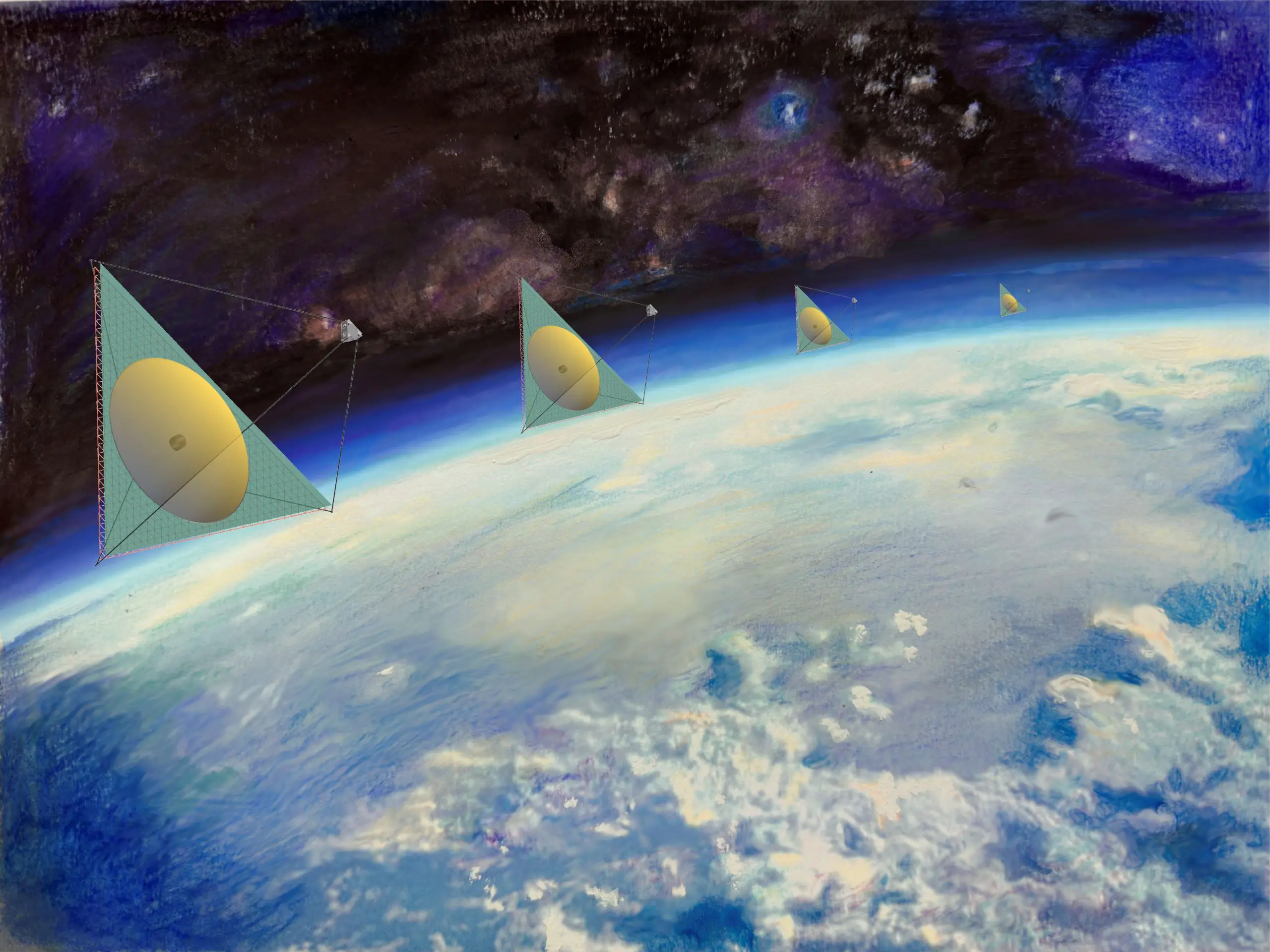Onderzoekers hebben een nieuwe methode ontwikkeld om telescopische spiegels te maken waarmee veel grotere en dus gevoeligere telescopen in een baan om de aarde kunnen worden gebracht. Credits: Sebastian Rabin, Max Planck Instituut voor buitenaardse fysica
De lichtgewicht en flexibele spiegels kunnen bij het lanceren compact worden ingeklapt en vervolgens nauwkeurig worden hervormd zodra ze zijn uitgevouwen.
Wetenschappers hebben een nieuwe methode ontwikkeld voor het produceren en vormgeven van grote, hoogwaardige spiegels, die veel dunner zijn dan de primaire spiegels die traditioneel in ruimtetelescopen worden gebruikt. Deze resulterende spiegels hebben voldoende flexibiliteit om tijdens de lancering efficiënt in een ruimtevaartuig te worden verpakt en verpakt.
“Het lanceren en inzetten van ruimtetelescopen is een complexe en dure procedure”, zegt Sebastien Rabian van het Max Planck Instituut voor Buitenaardse Fysica in Duitsland. “Deze nieuwe aanpak – die heel anders is dan de typische spiegelproductie- en polijstprocedures – zou kunnen helpen bij het oplossen van gewichts- en verpakkingsproblemen voor telescoopspiegels, waardoor grotere en dus gevoeligere telescopen in een baan om de aarde kunnen worden gebracht.”

De onderzoekers creëerden de spiegels door chemische dampafzetting te gebruiken om filmspiegels te laten groeien op een roterende vloeistof in een vacuümkamer. Hierdoor konden ze een dunne parabolische film maken die als primaire spiegel van een telescoop kon worden gebruikt door deze simpelweg te coaten met een reflecterend oppervlak zoals aluminium. Credits: Sebastian Rabin, Max Planck Instituut voor buitenaardse fysica
In Optica Publishing Group Magazine toegepaste optiekRabih rapporteerde over de succesvolle fabricage van prototypen van parabolische filmspiegels met een diameter tot 30 cm. Deze spiegels, die kunnen worden vergroot tot de vereiste afmetingen in ruimtetelescopen, zijn gemaakt door chemische dampafzetting te gebruiken om membraanspiegels te laten groeien op een roterende vloeistof in een vacuümkamer. Hij ontwikkelde ook een methode die warmte gebruikt om defecten die kunnen optreden na belichting van de spiegel adaptief te corrigeren.
“Hoewel dit werk alleen de haalbaarheid van de methoden aantoonde, legt het de basis voor grote, verpakbare spiegelsystemen die minder duur zijn”, zei Rabian. “Het zou lichtgewicht spiegels met een diameter van 15 of 20 meter kunnen realiseren, waardoor ruimtetelescopen mogelijk zijn die ordes van grootte gevoeliger zijn dan die welke momenteel worden ingezet of gepland.”
Een oud proces op een nieuwe manier toepassen
De nieuwe methode is ontwikkeld tijdens[{” attribute=””>COVID-19 pandemic, which Rabien says gave him some extra time to think and try out new concepts. “In a long series of tests, we researched many liquids to find out their usability for the process, investigated how the polymer growth can be carried out homogeneously, and worked to optimize the process,” he said.
For chemical vapor deposition, a precursor material is evaporated and thermally split into monomeric molecules. Those molecules deposit on the surfaces in a vacuum chamber and then combine to form a polymer. This process is commonly used to apply coatings such as the ones that make electronics water-resistant, but this is the first time it has been used to create parabolic membrane mirrors with the optical qualities necessary for use in telescopes.

Membrane mirrors made using the new technique are flexible enough to be rolled up. This could be helpful for storing the mirrors inside of a launch vehicle. Credit: Sebastian Rabien, Max Planck Institute for Extraterrestrial Physics
To create the precise shape necessary for a telescope mirror, the researchers added a rotating container filled with a small amount of liquid to the inside of the vacuum chamber. The liquid forms a perfect parabolic shape onto which the polymer can grow, forming the mirror base. When the polymer is thick enough, a reflective metal layer is applied to the top via evaporation and the liquid is washed away.
“It has long been known that rotating liquids that are aligned with the local gravitational axis will naturally form a paraboloid surface shape,” said Rabien. “Utilizing this basic physics phenomenon, we deposited a polymer onto this perfect optical surface, which formed a parabolic thin membrane that can be used as the primary mirror of a telescope once coated with a reflecting surface such as aluminum.”
Although other groups have created thin membranes for similar purposes, these mirrors are typically shaped using a high-quality optical mold. Using a liquid to form the shape is much more affordable and can be more easily scaled up to large sizes.
Reshaping a folded mirror
The thin and lightweight mirror created using this technique can easily be folded or rolled up during the trip to space. However, it would be nearly impossible to get it back to the perfect parabolic shape after unpacking. To reshape the membrane mirror, the researchers developed a thermal method that uses a localized temperature change created with light to enable adaptive shape control that can bring the thin membrane into the desired optical shape.
The researchers tested their approach by creating 30-cm diameter membrane mirrors in a vacuum deposition chamber. After much trial and error, they were able to produce high-quality mirrors with a surface shape suitable for telescopes. They also showed that their thermal radiative adaptive shaping method worked well, as demonstrated with an array of radiators and illumination from a digital light projector.
The new membrane-based mirrors could also be used in adaptive optics systems. Adaptive optics can improve the performance of optical systems by using a deformable mirror to compensate for distortion in incoming light. Because the surface of the new membrane mirrors is deformable, these mirrors could be shaped with electrostatic actuators to create deformable mirrors that are less expensive to make than those created with conventional methods.
Next, the researchers plan to apply more sophisticated adaptive control to study how well the final surface can be shaped and how much of an initial distortion can be tolerated. They also plan to create a meter-sized deposition chamber to better study the surface structure and packaging and unfolding processes for a large-scale primary mirror.
Reference: “Adaptive parabolic membrane mirrors for large deployable space telescopes” by Sebastian Rabien, 4 April 2023, Applied Optics.
DOI: 10.1364/AO.487262

“Amateur-organisator. Wannabe-bierevangelist. Algemene webfan. Gecertificeerde internetninja. Fanatieke lezer.”










More Stories
Wetenschappers bereiden zich voor op zonnestormen op Mars
Het hoogste observatorium ter wereld, hoog gelegen in de Andes in Chili, is eindelijk geopend
De robot beheerst het terrein via dierachtige loopovergangen